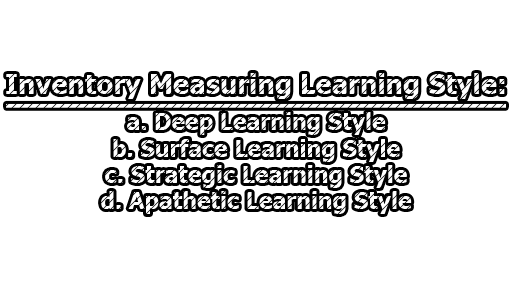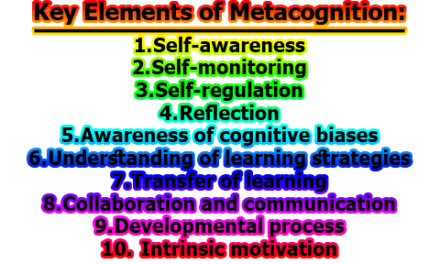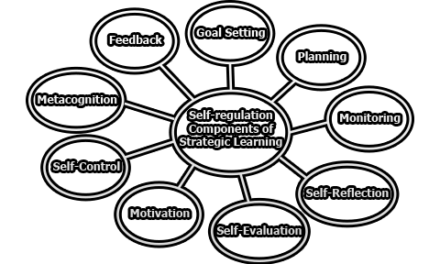Inventory Measuring Learning Style:
Learning is an ongoing process that involves the acquisition of knowledge, skills, and values. It is essential to understand that every person has a unique learning style that is most effective for them. The inventory measuring learning style is a tool used to assess how an individual learns and processes information. This tool is crucial for educators and trainers as it helps them create customized learning plans that meet the needs of their learners. In this article, we will discuss the four different learning styles that the inventory measuring learning style identifies, namely deep, surface, strategic, and apathetic. We will also explore how these learning styles impact an individual’s learning process and offer some tips on how to cater to each learning style.
a. Deep Learning Style:
Deep learners are characterized by their eagerness to understand the subject matter in-depth. They enjoy learning and are motivated by the desire to gain knowledge. Deep learners are known to think critically, analyze information, and connect it to prior knowledge. They seek to understand the underlying principles behind concepts and are not satisfied with surface-level information. They ask questions and are not afraid to challenge assumptions.
If you are a deep learner, you are likely to engage in activities such as conducting research, reading extensively, and seeking feedback. You prefer to work on complex tasks that require critical thinking and problem-solving skills. You may also enjoy discussing and debating ideas with others. As a deep learner, you are likely to have a good memory and an excellent ability to retain information.
Tips for catering to deep learners:
- Provide them with ample opportunities to research and explore topics of interest.
- Encourage them to ask questions and participate in discussions.
- Offer them complex tasks that require critical thinking and problem-solving skills.
- Provide them with feedback that is informative and challenging.
b. Surface Learning Style:
Surface learners are characterized by their tendency to focus on the surface-level aspects of a subject. They memorize facts and details but do not try to understand the underlying principles. Surface learners are motivated by the desire to achieve good grades or meet deadlines rather than by the love of learning.
If you are a surface learner, you are likely to engage in activities such as cramming, memorization, and regurgitation of information. You prefer to work on tasks that require little effort and can be completed quickly. As a surface learner, you may struggle with complex tasks that require critical thinking and problem-solving skills. You may also struggle to retain information if it is not presented in a straightforward manner.
Tips for catering to surface learners:
- Provide them with clear and concise information that is easy to memorize.
- Offer them tasks that are achievable in a short amount of time.
- Provide them with structured study guides and checklists.
- Break down complex tasks into smaller, more manageable parts.
c. Strategic Learning Style:
Strategic learners are characterized by their ability to use a range of learning strategies to achieve their goals. They are motivated by the desire to perform well and meet their objectives. Strategic learners are known to plan, organize, and prioritize their learning activities. They are excellent at time management and are good at balancing their academic and personal lives.
If you are a strategic learner, you are likely to engage in activities such as goal setting, time management, and self-reflection. You prefer to work on tasks that align with your objectives and priorities. You may also enjoy collaborating with others to achieve your goals. As a strategic learner, you are likely to have excellent organizational and time-management skills.
Tips for catering to strategic learners:
- Provide them with opportunities to set goals and develop plans to achieve them.
- Offer them tasks that align with their objectives and priorities.
- Provide them with tools to manage their time effectively, such as calendars and schedules.
- Encourage them to collaborate with others and share ideas and strategies.
d. Apathetic Learning Style:
Apathetic learners are characterized by their lack of motivation and interest in learning. They may feel disconnected from the subject matter or lack a sense of purpose. Apathetic learners may struggle to see the relevance of what they are learning and may feel disengaged from the learning process.
If you are an apathetic learner, you may struggle with procrastination, lack of focus, and disorganization. You may feel overwhelmed by complex tasks and may not see the value in putting in the effort to complete them. As an apathetic learner, you may need additional support and guidance to become motivated and engaged in the learning process.
Tips for catering to apathetic learners:
- Provide them with opportunities to connect the subject matter to their personal interests and goals.
- Offer them tasks that are relevant and applicable to their lives.
- Provide them with support and guidance to develop a sense of purpose and motivation.
- Offer them opportunities to work in small groups or with a mentor to build their confidence and engagement.
From the above discussion, we can say that the inventory measuring learning style is a valuable tool for educators and trainers to understand their learners’ unique learning styles. By identifying and catering to the four different learning styles, deep, surface, strategic, and apathetic, educators and trainers can create customized learning plans that meet the needs of their learners. It is important to remember that everyone learns differently, and by catering to each learning style, educators and trainers can create a more inclusive and effective learning environment.
References:
- Felder, R. M., & Silverman, L. K. (1988). Learning and teaching styles in engineering education. Engineering education, 78(7), 674-681.
- Kolb, D. A. (2014). Experiential learning: Experience as the source of learning and development. FT press.
- Biggs, J. B. (1999). Teaching for quality learning at university: What the student does (Vol. 11). McGraw-Hill Education (UK).
- Entwistle, N., & Ramsden, P. (2015). Understanding student learning. Routledge.
- Coffield, F., Moseley, D., Hall, E., & Ecclestone, K. (2004). Learning styles and pedagogy in post-16 learning: A systematic and critical review. Learning and Skills Research Centre London.
- Honey, P., & Mumford, A. (1992). The manual of learning styles. Peter Honey.
- Keefe, J. W. (1979). Learning style: An overview. In NASSP’s student learning styles: Diagnosing and prescribing programs (pp. 1-17).
- Riding, R., & Rayner, S. (2013). Cognitive styles and learning strategies: Understanding style differences in learning and behavior. Routledge.
- Smith, M. K., & Kolb, D. A. (2016). The Kolb learning style inventory—Version 4.0. Technical specifications. HayGroup.
- Vermunt, J. D. (1998). The regulation of constructive learning processes. British Journal of Educational Psychology, 68(2), 149-171.

Former Student at Rajshahi University










